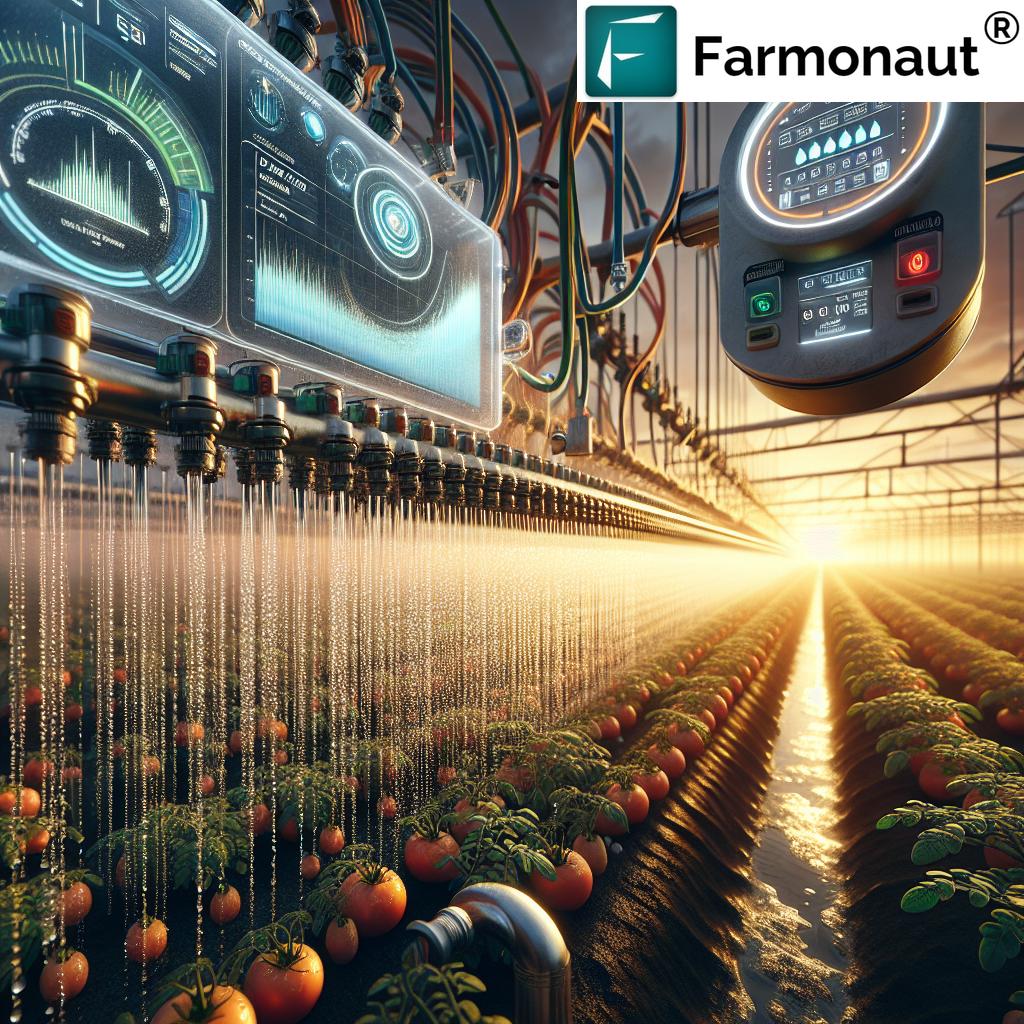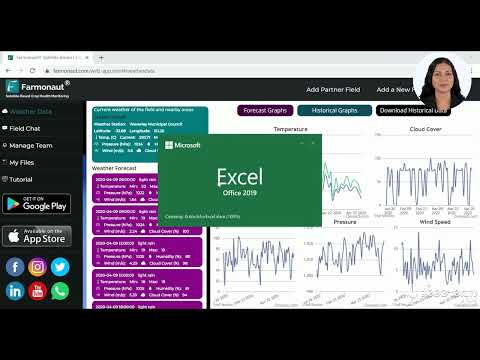Ultimate Guide: Boost Crop Yield with Smart Irrigation Management in Queensland Horticulture

“Queensland farmers can reduce water usage by up to 30% through smart irrigation management techniques.”
Welcome to our comprehensive guide on smart irrigation management for horticulture in Queensland! In this blog post, we’ll explore essential techniques to boost your water use efficiency in agriculture and maximize crop yields. As climate variability continues to challenge farmers across the state, implementing sustainable irrigation practices has become more crucial than ever.
At Farmonaut, we’re committed to helping growers optimize their irrigation strategies using cutting-edge technology and data-driven insights. Our satellite-based farm management solutions provide real-time crop health monitoring and AI-powered advisory systems to support informed decision-making.
Understanding Crop Water Requirements
Effective irrigation management starts with a thorough understanding of crop water requirements. Different horticultural crops have varying water needs depending on their growth stage, root depth, and environmental conditions. Here’s a breakdown of key factors to consider:
- Crop type and growth stage
- Soil moisture content
- Weather conditions (temperature, humidity, wind speed)
- Evapotranspiration rates
By accurately assessing these factors, you can tailor your irrigation schedule to meet your crops’ specific needs, avoiding both under-watering and over-watering scenarios.
Soil Moisture Monitoring Techniques
Monitoring soil moisture is crucial for maintaining optimal growing conditions and preventing water stress in your crops. Several methods are available for measuring soil moisture levels:
- Tensiometers: These devices measure soil water tension and are particularly useful for sandy soils.
- Capacitance probes: These sensors measure the dielectric constant of the soil, which is related to water content.
- Neutron probes: While more expensive, these provide accurate measurements of soil moisture at various depths.
- Satellite-based monitoring: Advanced technologies like Farmonaut’s platform use multispectral satellite imagery to assess soil moisture levels across large areas.
Implementing a combination of these techniques can provide a comprehensive picture of your soil’s moisture status, enabling more precise irrigation management.
Smart Irrigation Technology
Embracing smart irrigation technology can significantly improve water use efficiency and reduce labor costs. Some key innovations include:
- Automated irrigation controllers
- Weather-based irrigation systems
- Soil moisture sensor-controlled irrigation
- Variable rate irrigation systems
These technologies allow for precise control over water application, ensuring that crops receive the right amount of water at the right time. Farmonaut’s AI-driven Jeevn advisory system can integrate with smart irrigation systems to provide personalized recommendations based on real-time data and weather forecasts.
Irrigation Infrastructure Design
Proper design of irrigation infrastructure is essential for efficient water distribution and management. Key components to consider include:
- Water source and storage facilities
- Pump stations and filtration systems
- Mainlines and sub-mains
- Emitters or sprinklers
- Drainage systems
When designing your irrigation system, factors such as topography, soil type, and crop requirements should be taken into account. Consulting with irrigation specialists can help ensure that your system is optimized for your specific farm conditions.
Infield Application Methods
Choosing the right infield application method is crucial for maximizing water use efficiency. Common methods used in Queensland horticulture include:
- Drip irrigation: Highly efficient for row crops and tree fruits, delivering water directly to the root zone.
- Micro-sprinklers: Suitable for orchards and vineyards, providing uniform coverage over a larger area.
- Sprinkler systems: Including handshift, solid set, and center pivot systems, these are versatile for various crop types.
- Travelling guns: Useful for large open fields but may have lower efficiency due to wind drift and evaporation losses.
Each method has its advantages and limitations, and the choice depends on factors such as crop type, field size, water availability, and labor considerations.
Water Conservation Strategies
Implementing water conservation strategies is essential for sustainable horticulture in Queensland. Some effective approaches include:
- Mulching to reduce evaporation
- Contour planting to minimize runoff
- Cover cropping to improve soil structure and water retention
- Windbreaks to reduce evapotranspiration
- Rainwater harvesting and storage
These practices not only conserve water but also contribute to overall soil health and farm sustainability.
“Proper irrigation scheduling can increase crop yields by 15-25% compared to traditional methods in horticulture.”
Salinity Management in Irrigation
Salinity is a significant concern in many Queensland horticultural regions. Effective salinity management strategies include:
- Regular soil testing to monitor salt levels
- Leaching to flush excess salts from the root zone
- Using salt-tolerant crop varieties
- Improving drainage to prevent salt accumulation
- Adjusting irrigation frequency and volume to minimize salt buildup
By implementing these practices, growers can maintain soil health and prevent yield losses due to salinity stress.
Water Reuse and Recycling
Incorporating water reuse and recycling into your irrigation management plan can significantly reduce overall water consumption. Consider the following options:
- Capturing and treating runoff water
- Reusing tailwater from irrigation systems
- Implementing closed-loop hydroponic systems
- Utilizing treated wastewater for irrigation (where permissible)
Proper filtration and treatment are essential when reusing water to prevent the spread of pathogens and maintain water quality.
Explore Farmonaut’s API for advanced data integration
Drought Management Strategies
Preparing for and managing drought conditions is crucial for Queensland horticulture. Key strategies include:
- Developing a drought management plan
- Implementing deficit irrigation techniques
- Prioritizing water allocation among crops
- Investing in drought-resistant crop varieties
- Utilizing mulch and other moisture retention techniques
Farmonaut’s satellite-based monitoring can help detect early signs of drought stress, allowing for timely interventions.
Crop-Specific Irrigation Management
Different horticultural crops have unique irrigation requirements. Here’s a brief overview of irrigation management for some key Queensland crops:
Avocados
- Sensitive to over-watering and poor drainage
- Require consistent soil moisture without waterlogging
- Benefit from mulching and micro-sprinkler irrigation
Citrus
- Need regular irrigation during fruit development
- Benefit from deficit irrigation during specific growth stages
- Drip irrigation is highly effective for water conservation
Bananas
- Require high water input, especially during bunch development
- Benefit from frequent, light irrigations
- Overhead sprinkler systems are commonly used
Mangoes
- Require careful water management to induce flowering
- Need consistent irrigation during fruit development
- Drip or micro-sprinkler systems are effective
Tomatoes
- Sensitive to water stress, especially during fruit set
- Benefit from mulching and drip irrigation
- Require precise irrigation scheduling to prevent diseases
Access Farmonaut’s API Developer Docs for custom solutions
Irrigation System Maintenance
Regular maintenance of your irrigation system is crucial for optimal performance and water use efficiency. Key maintenance tasks include:
- Inspecting and repairing leaks
- Cleaning filters and emitters
- Checking and calibrating pressure regulators
- Flushing pipes and lines
- Monitoring pump performance
Implementing a routine maintenance schedule can prevent costly breakdowns and ensure consistent water distribution.
Water Use Efficiency Benchmarking
Benchmarking your farm’s water use efficiency against industry standards can help identify areas for improvement. Key performance indicators to track include:
- Crop water use efficiency (yield per unit of water applied)
- Irrigation application efficiency
- Water productivity (economic return per unit of water used)
Farmonaut’s platform can help you track these metrics and compare them with regional benchmarks, enabling data-driven decision-making for irrigation management.
Irrigation Management Techniques Comparison
| Irrigation Method | Water Use Efficiency (%) | Crop Yield Impact (%) | Initial Cost | Maintenance Requirements | Suitability for Different Soil Types | Drought Resistance |
|---|---|---|---|---|---|---|
| Drip Irrigation | 90-95 | 10-25 | High | Medium | Most soil types | High |
| Sprinklers | 70-80 | 5-15 | Medium | Low | Most soil types | Medium |
| Travelling Guns | 60-70 | 0-10 | Medium | Medium | Large, open fields | Low |
| Smart Irrigation Systems | 85-95 | 15-30 | High | Low | All soil types | High |
Future Trends in Irrigation Management
As technology continues to evolve, several exciting trends are emerging in irrigation management:
- Artificial intelligence and machine learning for predictive irrigation scheduling
- Internet of Things (IoT) sensors for real-time monitoring and control
- Precision irrigation using drones and satellite imagery
- Blockchain technology for water rights management and traceability
Staying informed about these trends can help Queensland horticulturists remain competitive and sustainable in the face of changing climatic conditions.
Conclusion
Implementing smart irrigation management techniques is essential for boosting crop yields and ensuring the long-term sustainability of Queensland’s horticultural industry. By leveraging advanced technologies, such as Farmonaut’s satellite-based monitoring and AI advisory systems, growers can optimize their water use efficiency, reduce costs, and improve overall farm profitability.
Remember that effective irrigation management is an ongoing process that requires continuous monitoring, adaptation, and improvement. Stay informed about the latest research and technologies, and don’t hesitate to seek expert advice when needed.
FAQs
- Q: How often should I monitor soil moisture levels?
A: It’s best to monitor soil moisture daily, especially during critical growth stages or in periods of high water demand. - Q: Can I use Farmonaut’s platform for all types of horticultural crops?
A: Yes, Farmonaut’s satellite-based monitoring and AI advisory systems are adaptable to various crop types and can provide valuable insights for most horticultural operations. - Q: How can I improve the water use efficiency of my existing irrigation system?
A: Regular maintenance, upgrading to more efficient emitters, implementing smart controllers, and using soil moisture sensors can all help improve water use efficiency. - Q: What are the benefits of using satellite imagery for irrigation management?
A: Satellite imagery provides a comprehensive view of crop health and soil moisture across large areas, enabling more precise and timely irrigation decisions. - Q: How can I determine the right irrigation schedule for my crops?
A: Consider factors such as crop type, growth stage, soil type, weather conditions, and evapotranspiration rates. Farmonaut’s AI advisory system can help generate personalized irrigation schedules based on these factors.







